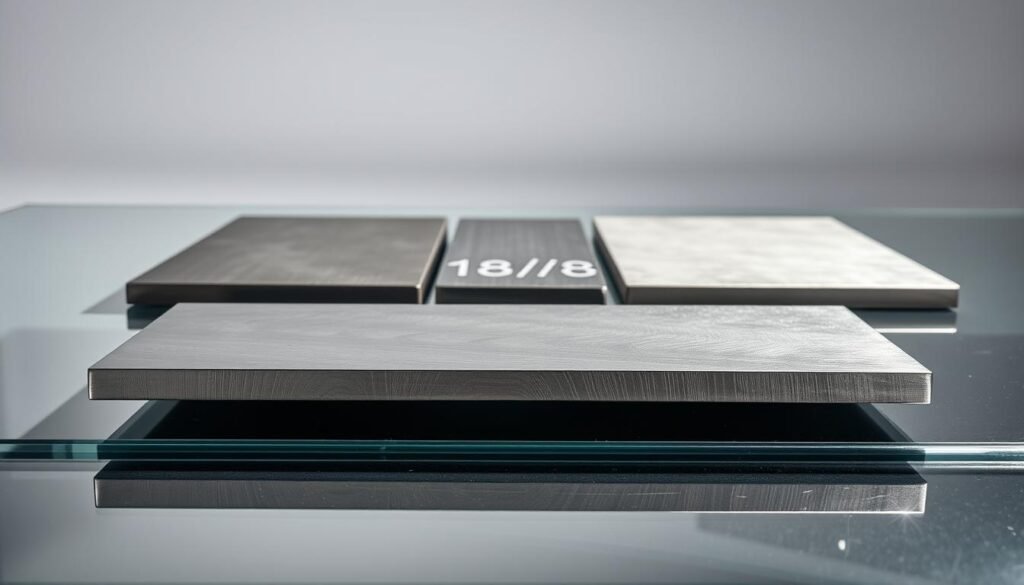18/8 stainless steel is one of the most widely used stainless steel grades in various industries due to its excellent balance of properties and cost-effectiveness.
The designation “18/8” refers to its composition of approximately 18% chromium and 8% nickel, giving it distinctive corrosion resistance and other beneficial characteristics.
Belonging to the 300 series of austenitic stainless steels, 18/8 steel is known for its non-magnetic properties and excellent formability, making it a versatile material for numerous applications.
Often used interchangeably with 304 stainless steel in many applications, though there are some technical differences between the grades. This article will explore the composition, properties, comparisons with other grades, advantages, limitations, and common uses of 18/8 stainless steel.
Understanding 18/8 Stainless Steel
Understanding the composition and properties of 18/8 stainless steel is crucial for determining its suitability for different applications. This type of stainless steel is known for its durability and resistance to corrosion, making it a popular choice in various industries.
Composition and Naming Convention
The designation “18/8” is derived from the material’s composition, specifically the percentages of chromium and nickel it contains.
The Meaning Behind 18/8 Designation
The “18/8” designation signifies that the stainless steel contains 18% chromium and 8% nickel. This composition is fundamental to its corrosion resistance and mechanical properties.
Chemical Makeup and Structure
The chemical makeup of 18/8 stainless steel includes a significant amount of chromium, which forms a protective oxide layer on the surface, enhancing its corrosion resistance. Its austenitic structure, primarily due to the nickel content, makes it non-magnetic and provides good ductility.
Key Properties of 18/8 Stainless Steel
18/8 stainless steel exhibits a range of properties that make it suitable for various applications.
Corrosion Resistance Capabilities
Its corrosion resistance is one of its most significant advantages, attributed to its chromium content. This property makes it ideal for use in environments where exposure to corrosive substances is a concern.
Mechanical and Physical Properties
Mechanical Properties: 18/8 stainless steel has a tensile strength of 540-750 MPa and yield strength, with an elongation capability of approximately 70%.
The physical properties include a density of 7.87-8.07 g/cm³, a melting point around 1,450°C, and thermal conductivity of 16.2 W/m·K.

| Property | Value | Description |
|---|---|---|
| Tensile Strength | 540-750 MPa | Measure of the material’s resistance to breaking under tension |
| Density | 7.87-8.07 g/cm³ | Mass per unit volume of the material |
| Melting Point | Around 1,450°C | Temperature at which the material changes state from solid to liquid |
18/8 Stainless Steel vs. Other Grades
Different grades of stainless steel are suited for different applications, making the selection process critical. The choice between various grades depends on factors such as corrosion resistance, durability, and aesthetic appeal.
Comparing 18/8 and 304 Stainless Steel
The comparison between 18/8 and 304 stainless steel is significant because they are often considered interchangeable due to their similar composition.
Similarities and Differences
Both 18/8 and 304 stainless steel contain 18% chromium and 8% nickel, making them very similar in terms of corrosion resistance and durability. However, 304 is an American grade, while 18/8 is more commonly referenced in the context of consumer products.
When They’re Used Interchangeably
In many cases, 18/8 and 304 stainless steel are used interchangeably, particularly in applications where the specific grade is not strictly regulated.
Comparing 18/8 and 316 Stainless Steel
316 stainless steel is known for its enhanced corrosion resistance due to the addition of molybdenum.
The Role of Molybdenum in 316
Molybdenum adds a layer of protection against corrosive substances, making 316 stainless steel ideal for harsh environments.
Performance in Harsh Environments
In environments exposed to high levels of salt or acidic substances, 316 stainless steel outperforms 18/8 due to its superior corrosion resistance.
Comparing 18/8 and 18/10 Stainless Steel
The primary difference between 18/8 and 18/10 stainless steel lies in their nickel content, which affects their quality and appearance.
Nickel Content Differences
18/10 stainless steel contains 10% nickel, compared to 8% in 18/8, enhancing its corrosion resistance and giving it a shinier appearance.
Impact on Durability and Appearance
The higher nickel content in 18/10 stainless steel not only improves its durability but also its aesthetic appeal, making it a popular option for premium kitchenware.
| Grade | Chromium Content | Nickel Content | Molybdenum Content | Corrosion Resistance |
|---|---|---|---|---|
| 18/8 | 18% | 8% | 0% | Good |
| 304 | 18% | 8% | 0% | Good |
| 316 | 16-18% | 10-14% | 2-3% | Excellent |
| 18/10 | 18% | 10% | 0% | Very Good |

Advantages and Limitations of 18/8 Stainless Steel
The advantages and limitations of 18/8 stainless steel are crucial factors in determining its suitability for different uses. This material is widely recognized for its beneficial properties, but like any other material, it also has its drawbacks.
Benefits of Choosing 18/8 Stainless Steel
18/8 stainless steel offers several benefits that make it a popular choice across various industries. Some of the key advantages include its durability, cost-effectiveness, and food safety.
Durability and Strength
Durability is a significant advantage of 18/8 stainless steel. It exhibits high strength and resistance to corrosion, making it suitable for applications where exposure to harsh environments is a concern. The material’s ability to withstand wear and tear without degrading significantly contributes to its long lifespan.
Cost-Effectiveness
Another benefit is its cost-effectiveness. Compared to other grades of stainless steel, 18/8 stainless steel often provides a favorable balance between performance and cost. This makes it an attractive option for manufacturers and consumers looking for quality without excessive expense.
Food Safety and Non-Reactivity
The non-reactive nature of 18/8 stainless steel ensures food safety. It does not leach harmful chemicals into food, making it ideal for kitchen utensils, cookware, and food processing equipment. This property is particularly valuable in applications where hygiene and safety are paramount.
Limitations to Consider
Despite its many advantages, 18/8 stainless steel has certain limitations that need to be considered. These include its vulnerability to certain environments and limitations related to its magnetic properties and heat treatment.
Vulnerability to Certain Environments
18/8 stainless steel can be vulnerable in environments that are highly corrosive or contain high levels of chlorides. In such conditions, it may be more prone to corrosion than other grades of stainless steel, such as 316.
Magnetic Properties and Heat Treatment Limitations
Generally, 18/8 stainless steel is non-magnetic in its annealed state due to its austenitic structure. However, cold working can induce magnetism, creating variability in its magnetic response. Additionally, unlike some other types of stainless steel, 18/8 cannot be hardened through conventional heat treatment processes; it can only be strengthened through cold working.
The comparison below highlights some key differences between 18/8 stainless steel and other grades in terms of heat resistance and magnetic properties.
| Grade | Heat Resistance | Magnetic Properties |
|---|---|---|
| 18/8 Stainless Steel | Good at moderate temperatures | Non-magnetic (annealed), can become magnetic with cold working |
| 304 Stainless Steel | Similar to 18/8 | Generally non-magnetic |
| 316 Stainless Steel | Better than 18/8 at high temperatures | Non-magnetic |
Common Applications of 18/8 Stainless Steel
The versatility of 18/8 stainless steel makes it a preferred material across various industries. Its unique blend of properties, including corrosion resistance and durability, makes it suitable for a wide range of applications.
Kitchen and Food Industry Uses
In the kitchen and food industry, 18/8 stainless steel is highly valued for its cleanability and resistance to corrosion. It is commonly used in the manufacture of cooking utensils, cutlery, and equipment for food processing. The material’s ability to withstand various environmental conditions without degrading makes it an ideal choice for commercial kitchens and food service establishments.
Industrial and Commercial Applications
Beyond the kitchen, 18/8 stainless steel is utilized in various industrial and commercial settings. Its applications include chemical processing equipment, pharmaceutical manufacturing components, and architectural elements, where its durability and resistance to corrosion are beneficial. Additionally, it is used in the medical and healthcare industries for equipment and surgical instruments due to its cleanability and ability to resist corrosion in a non-marine environment.
Conclusion
The examination of 18/8 stainless steel highlights its significant advantages, including its balanced combination of properties and cost-effectiveness. This grade of stainless steel is composed of 18% chromium and 8% nickel, which creates its distinctive properties and performance characteristics.
When compared to other grades like 304, 316, and 18/10, 18/8 stainless steel offers a unique set of benefits and limitations. Its excellent corrosion resistance makes it suitable for various applications, but it may not be ideal for highly corrosive environments.
In conclusion, 18/8 stainless steel remains a relevant material in modern manufacturing due to its proven track record and excellent balance of properties. As new specialty alloys emerge, 18/8 stainless steel continues to be a top choice for many industries.
